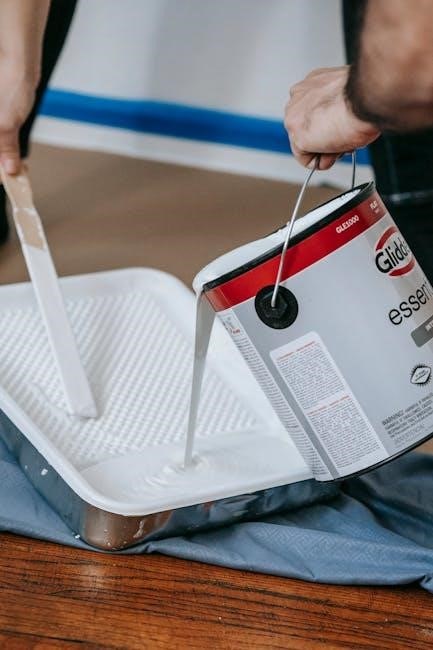Welcome to the CAN ICES-3 B/NMB-3 B Manual. This guide provides essential information for safe and compliant device operation, covering installation, troubleshooting, and environmental considerations.
1.1 Overview of the Manual
This manual provides comprehensive guidance for the CAN ICES-3 B/NMB-3 B device, ensuring compliance with regulatory standards and safe operation. It covers installation, troubleshooting, and environmental considerations, while emphasizing proper usage to avoid interference. The document is structured to help users understand device parameters, maintenance requirements, and performance optimization. By adhering to the guidelines, users can ensure optimal functionality and minimize risks. This manual is essential for anyone operating or maintaining the device, offering clear instructions and safety precautions to guarantee compliance with Industry Canada and FCC regulations.
1.2 Importance of Compliance and Safety
Compliance with regulatory standards ensures proper device operation and avoids legal issues. This manual emphasizes adherence to Industry Canada (ISED) and FCC Part 15 requirements, which mandate that devices must not cause harmful interference and must tolerate external interference. Safety is paramount, with warnings against water exposure and improper cleaning. Failure to comply may void the device’s authority to operate. Adhering to these guidelines ensures optimal performance, legal operation, and user safety, while preventing potential environmental or operational risks associated with non-compliant usage.
Compliance and Regulatory Information
This section outlines the regulatory requirements for the CAN ICES-3 B/NMB-3 B device, ensuring compliance with Industry Canada (ISED) and FCC Part 15 standards to prevent interference.
2.1 CAN ICES-3 (B)/NMB-3 (B) Compliance
The device complies with Industry Canada’s ICES-003 standard, ensuring operation under specific conditions. It must not cause harmful interference and must accept any received interference. Modifications without approval can void compliance certification. Adherence to these regulations ensures proper functionality and legal operation. Users must follow all guidelines to maintain compliance and avoid potential penalties. Proper usage and adherence to safety standards are critical for uninterrupted service. Always refer to the manual for detailed compliance requirements and updates.
2.2 Industry Canada (ISED) Compliance Requirements
This device complies with Industry Canada’s ICES-003 standard, operating under license-exempt conditions. It must not cause harmful interference and must accept any interference received. Compliance ensures proper functionality and legal operation. Users must adhere to all regulations to maintain certification and avoid penalties. Modifications without approval can void compliance. Proper usage and adherence to safety standards are critical for uninterrupted service. Always refer to the manual for detailed compliance requirements and updates to ensure continued adherence to Industry Canada’s guidelines.
2.3 FCC Part 15 Compliance

This device complies with FCC Part 15 rules, operating under two conditions: it must not cause harmful interference, and it must accept any interference received. Compliance ensures proper functionality and legal operation in the United States. Users must adhere to all regulations to maintain certification and avoid penalties. Modifications without FCC approval can void the user’s authority to operate the equipment. Proper usage and adherence to safety standards are critical for uninterrupted service. Always refer to the manual for detailed compliance requirements and updates to ensure continued adherence to FCC guidelines.

Safety Instructions
Ensure safe operation by following all warnings and guidelines. Avoid water exposure, clean with a dry cloth, and prevent ventilation blockage to maintain device integrity and user safety.
3.1 General Safety Precautions
To ensure safe operation, adhere to all guidelines and warnings provided. Avoid using the device near water, clean only with a dry cloth, and prevent blocking ventilation openings. Always follow the manufacturer’s instructions to maintain device integrity and user safety. Proper handling and storage are crucial to prevent damage and ensure optimal performance. Failure to comply may result in device malfunction or safety hazards. Regularly inspect the device for damage and ensure all safety measures are strictly followed.
3.2 Warning Labels and Symbols
Warning labels and symbols are provided to ensure safe and proper use of the device. They indicate potential hazards and essential precautions. The device complies with ICES-003 and FCC Part 15 requirements, ensuring minimal interference. Key warnings include avoiding water exposure, using only dry cloths for cleaning, and not blocking ventilation openings. Failure to heed these warnings may result in device malfunction or safety risks. Always read and follow all labeled instructions carefully to maintain compliance and ensure safe operation. These labels are critical for preventing accidents and ensuring optimal device performance. Adherence is mandatory for user safety and regulatory compliance.
3.3 Proper Handling and Storage
Proper handling and storage are crucial to maintain the device’s functionality and safety. Avoid exposing the device to water or moisture, as this can cause damage. Clean only with a dry cloth to prevent electrical issues. Store the device in a cool, dry place, away from direct sunlight and moisture. Handle the device with care to prevent physical damage. Ensure proper ventilation to avoid overheating. Avoid extreme temperatures and humidity levels. Store the device in its original packaging if possible to protect it during transport. Always follow these guidelines to ensure optimal performance and longevity of the device.

Operational Guidelines
Operational guidelines ensure safe and effective use of the device. Adhere to specified conditions to avoid interference and ensure compliance with regulatory standards. Proper handling and environmental considerations are essential for optimal performance and longevity.
4.1 Device Operation Conditions
The device must operate under specified conditions to ensure compliance and safety. Maintain a stable power supply, avoid extreme temperatures, and keep humidity levels within recommended ranges. Ensure proper ventilation to prevent overheating. Avoid exposing the device to water or moisture, as this can cause malfunction. Use only approved accessories and follow all safety precautions. Regularly check for firmware updates to maintain optimal performance. Ensure the device is installed in an environment free from interference sources. Adhere to all regulatory standards for uninterrupted and safe operation.
4.2 Interference Prevention Measures
To ensure optimal performance, prevent interference by maintaining a safe distance from other electronic devices. Use high-quality, shielded cables to minimize signal disruption. Avoid placing the device near sources of strong electromagnetic fields. Regularly inspect antennas and connections for damage or corrosion. Ensure the device is operated in an environment with minimal radio frequency interference. Keep the device away from water and moisture, as this can exacerbate interference issues. Follow the manufacturer’s guidelines for proper installation and configuration to maintain compliance with regulatory standards.
4.3 Environmental Considerations
Ensure the device operates within specified temperature and humidity ranges to maintain performance. Avoid exposing the device to extreme conditions, such as high heat or moisture, which can damage components. Keep the device away from direct sunlight and ensure proper ventilation to prevent overheating. Avoid physical stress, such as dropping or bending, which can cause internal damage. Regularly clean the device with a dry cloth to prevent dust buildup. Store the device in a dry, cool place when not in use to prolong its lifespan and ensure compliance with environmental regulations.
Installation and Maintenance
Proper installation and regular maintenance ensure optimal performance. Follow guidelines to avoid unauthorized modifications, which can void compliance. Clean with a dry cloth and avoid water exposure.
5.1 Step-by-Step Installation Guide
Carefully unbox and inspect the device for damage. Ensure all components are included.

Choose a safe, dry location away from water sources and ensure proper ventilation.
Connect the device to the power source and other required systems, following the manual.
Turn on the device and perform a self-test to ensure proper functionality.
Refer to the manual for configuration settings and save your preferences.

Regularly update software and firmware to maintain compliance and performance;
Remember to follow all safety guidelines and avoid unauthorized modifications to ensure compliance with regulatory standards.
5.2 Routine Maintenance Requirements
Regular maintenance ensures optimal performance and compliance. Clean vents to prevent dust buildup and check for obstructions. Use a dry cloth to wipe surfaces, avoiding liquids. Inspect cables for damage and replace if necessary. Update software and firmware periodically. Ensure the device remains dry and store it in a cool, dry place when not in use. Refer to the manual for detailed maintenance schedules and guidelines to maintain compliance with regulatory standards and ensure longevity of the device.
5.3 Troubleshooting Common Issues
Identify and resolve common issues promptly to ensure optimal performance. Check for interference sources and ensure proper device placement. For connectivity problems, restart the device or check cable connections. If performance issues arise, refer to compliance standards like ISED and FCC guidelines. Address power-related problems by ensuring stable electricity supply. Clean vents regularly to prevent overheating. For persistent issues, consult the manual or contact technical support. Always follow safety guidelines to avoid further complications during troubleshooting.
Technical Specifications
The device complies with ISED and FCC standards, ensuring reliable operation under specified conditions. It supports license-exempt RSS standards and operates within designated environmental parameters for optimal performance.

6.1 Device Parameters and Limits
The CAN ICES-3 B/NMB-3 B device operates within specified frequency ranges and power limits to ensure compliance with regulatory standards. It is designed to function effectively under normal environmental conditions, with defined temperature and humidity thresholds. The device incorporates safety features to prevent overheating and electrical hazards. Users must adhere to the specified parameters to maintain optimal performance and avoid damage. Compliance with emissions standards ensures minimal interference with other electronic devices. Proper operation within these limits guarantees reliability and longevity of the device.
6.2 Compatibility with Other Systems
The CAN ICES-3 B/NMB-3 B device is designed to integrate seamlessly with other systems, ensuring minimal interference and optimal performance. It adheres to Industry Canada and FCC standards, making it compatible with a wide range of electronic devices. Proper installation and configuration are essential to maintain compatibility. Users should verify system specifications and ensure all connected devices meet regulatory requirements. Regular testing and updates can help maintain smooth operation and prevent conflicts with other equipment. This ensures reliable functionality across various environments and setups.
6.3 Performance Optimization Tips
To enhance device performance, ensure proper installation and configuration as per the manual. Regularly clean the device with a dry cloth to prevent dust buildup. Avoid exposing the device to water or moisture, as this can degrade performance. Maintain good ventilation to prevent overheating. Follow the recommended operating conditions and update settings as needed. By adhering to these guidelines, you can optimize the device’s functionality and ensure reliable operation. Proper handling and storage are also crucial for maintaining peak performance levels over time.

Usage Guidelines
Use the device in dry environments, avoid water exposure, and clean only with a dry cloth. Ensure proper ventilation to prevent overheating and maintain optimal performance.
7.1 Proper Usage Environments
The device should be operated in environments with temperatures between 0°C and 40°C (32°F to 104°F) and humidity levels below 80%. Avoid exposing the device to water or moisture. Ensure proper ventilation to prevent overheating. Use the device on a stable, flat surface and avoid blocking ventilation openings. Keep the device away from direct sunlight and extreme temperatures. Ensure the power supply meets the specified requirements. Follow all safety guidelines to maintain optimal performance and compliance with regulatory standards.
7.2 Avoiding Water Exposure
Prevent water exposure to ensure device functionality and safety. Do not use the device near water sources or in humid environments. Avoid spilling liquids on the device. Clean only with a dry cloth, as moisture can damage internal components. Ensure the device is stored in a dry, well-ventilated area. Water exposure may void the warranty or cause permanent damage. Always follow the manufacturer’s guidelines to maintain compliance and prevent malfunctions. Proper handling will ensure optimal performance and longevity of the device.
7.3 Cleaning and Maintenance Tips
Regular cleaning and maintenance ensure optimal performance and longevity of the device. Use a soft, dry cloth to wipe surfaces, avoiding harsh chemicals or liquids. Never submerge the device in water or expose it to excessive moisture. Check for dust buildup in ventilation openings and clean gently with compressed air. Avoid blocking airflow to prevent overheating. Store the device in a dry, cool environment when not in use. Follow these guidelines to maintain compliance and ensure reliable operation. Refer to the manual for detailed care instructions.

Advanced Features and Configurations
This section explores advanced customization options, performance optimization techniques, and integration methods to enhance device functionality, ensuring compliance with regulatory standards for optimal operation.
8;1 Custom Settings and Adjustments
Access advanced settings via the control panel to customize device operation. Adjust frequency, power levels, and transmission modes to suit specific applications. Ensure all modifications comply with regulatory standards to avoid non-compliance issues. Use diagnostic tools to monitor and optimize performance. Refer to the troubleshooting section for resolving configuration conflicts. Always consult the manual before making significant changes to ensure safe and efficient operation. Proper adjustments can enhance functionality while maintaining compliance with ICES-3 B/NMB-3 B requirements.
8.2 Enhancing Device Performance
Optimize device performance by ensuring proper installation and configuration. Regularly update firmware to access new features and improvements. Adjust settings to minimize interference and maximize signal strength. Use diagnostic tools to monitor performance metrics and identify areas for improvement. Ensure compliance with ICES-3 B/NMB-3 B standards during any modifications. Maintain optimal operating conditions, such as temperature and humidity levels, to prevent degradation. Clean the device regularly and avoid exposure to water or extreme environments. Proper care and adjustments will ensure reliable and efficient operation, adhering to safety and regulatory guidelines.
8.3 Integration with Other Devices
Ensure seamless integration of the CAN ICES-3 B/NMB-3 B device with other systems by following compatibility guidelines. Check the device’s communication protocols and ensure they align with connected systems. Proper configuration is essential to prevent interference and maintain compliance with ICES-3 B/NMB-3 B standards. Refer to the manual for specific instructions on connecting to external devices. Test the setup to confirm data transmission accuracy and system stability. Regularly update firmware to support new integrations and enhance compatibility. Proper integration ensures efficient operation and maximizes device functionality while adhering to safety and regulatory requirements.
Troubleshooting and Error Handling
Identify and resolve issues promptly using diagnostic tools. Refer to error codes for specific solutions. Regular system checks prevent recurring problems and ensure optimal performance.
9.1 Common Errors and Solutions
Common errors include interference issues, improper device handling, and non-compliance with safety guidelines. Solutions involve checking connections, ensuring compliance with ICES-003 standards, and following proper maintenance procedures. Regularly clean vents and avoid water exposure to prevent damage. Refer to diagnostic tools for error codes and resolve issues promptly to maintain optimal performance and safety. Always adhere to manufacturer guidelines to prevent recurring problems and ensure reliable operation.
9.2 Diagnostic Tools and Techniques
Use diagnostic tools to identify and resolve device issues. Check error logs for specific fault codes and perform signal strength tests to ensure compliance with ICES-003 standards. Regularly audit device settings to prevent interference and ensure proper operation. Utilize compliance verification tools to confirm adherence to FCC Part 15 and ISED requirements. Refer to the manual for detailed troubleshooting steps and maintain a record of diagnostics for future reference. Proper diagnostic techniques ensure reliable performance and safety, aligning with regulatory guidelines.
9.3 Resetting the Device
To reset the device, disconnect it from the power source for 30 seconds. This ensures all systems reboot properly. After reconnecting, follow the manual’s initialization steps. Resetting restores default settings, resolving minor issues. Always ensure compliance with ICES-003 and FCC Part 15 standards post-reset. If issues persist, consult diagnostic tools or contact support. Proper resetting maintains device performance and safety, adhering to regulatory guidelines. Refer to the manual for detailed reset procedures and safety precautions to avoid interference or operational failures.
Environmental and Disposal Considerations
Ensure eco-friendly disposal by recycling device components. Follow local regulations to minimize environmental impact. Proper disposal prevents hazardous waste, adhering to ICES-003 and FCC guidelines for sustainability.
10.1 Eco-Friendly Disposal Practices
Dispose of the device responsibly to minimize environmental impact. Recycle components like batteries and electronics through authorized facilities. Avoid landfill disposal to prevent hazardous waste; Ensure compliance with local regulations and ICES-003 guidelines for eco-friendly practices.
Remove any hazardous materials before recycling. Consult local authorities for proper disposal methods. Proper recycling helps conserve resources and reduces environmental harm, aligning with sustainability goals.
10.2 Recycling Guidelines
Recycle the device and its components responsibly. Separate batteries and electronic parts for proper processing. Use authorized recycling facilities to ensure compliance with environmental standards. Follow local regulations and ICES-003 guidelines for recycling electronic waste. Proper recycling helps recover valuable materials and reduces landfill waste. Check with local authorities for designated recycling centers. Ensure all data is erased before recycling. Avoid improper disposal to prevent environmental harm. Recycling supports sustainability and resource conservation, aligning with eco-friendly practices.
10.3 Reducing Environmental Impact
To minimize environmental impact, ensure proper disposal and recycling of the device. Use energy-efficient settings and avoid unnecessary power consumption. Follow ICES-003 guidelines for eco-friendly practices. Recycle batteries and electronic components separately. Avoid disposing of the device in regular trash to prevent landfill contamination. Use biodegradable packaging when possible. Regularly update software to optimize performance and reduce resource usage. Promote sustainability by adhering to environmental regulations and manufacturer recommendations. Proper handling and recycling contribute to a greener future and resource conservation.
Adherence to this manual ensures compliance, safety, and optimal device performance. Proper handling and storage are crucial for longevity and environmental responsibility. Always follow guidelines for best results.
11.1 Summary of Key Points
This manual emphasizes compliance with regulatory standards like CAN ICES-3 B/NMB-3 B, ensuring safe and efficient device operation. Key points include adhering to safety precautions, avoiding water exposure, and proper cleaning methods. Compliance with Industry Canada (ISED) and FCC Part 15 requirements is mandatory to maintain operational authority. Users must avoid modifications not approved by regulatory bodies to prevent interference and ensure device longevity. Proper handling, storage, and environmental considerations are vital for optimal performance and eco-friendly practices. Always follow guidelines to uphold safety and compliance standards.
11.2 Final Safety Reminders
Always read and follow the manual instructions carefully to ensure safe operation. Avoid using the device near water and clean only with a dry cloth to prevent damage. Do not block ventilation openings, as this may cause overheating. Heed all warnings and adhere to safety guidelines to prevent potential hazards. Proper handling and storage are essential to maintain device performance and longevity. By following these reminders, you can ensure a safe and compliant user experience while minimizing risks associated with improper use.
11.3 Importance of Adhering to Guidelines
Adhering to the guidelines in this manual ensures compliance with regulatory standards, such as ISED and FCC requirements, and maintains your authority to operate the device. Compliance prevents legal issues and guarantees safe operation. Following safety instructions minimizes risks of damage or harm. Proper handling and storage prolong the device’s lifespan. Eco-friendly disposal practices reduce environmental impact. By adhering to these guidelines, you ensure reliable performance, safety, and environmental responsibility, aligning with legal and ethical standards for device usage and disposal.
References and Further Reading
Refer to ICES-003, FCC Part 15, and Industry Canada compliance documents for detailed regulatory standards. Visit the manufacturer’s website for additional resources and safety literature.
12.1 Relevant Regulatory Documents
Key regulatory documents include ICES-003 and FCC Part 15, outlining compliance standards for device operation. These documents ensure adherence to interference prevention and safety guidelines. Industry Canada’s RSS standards are also referenced, detailing license-exempt requirements. Users must consult these documents for detailed operational conditions and technical specifications. They provide essential guidelines for proper device usage and environmental considerations, ensuring compliance with national regulations. Referencing these documents is crucial for understanding and maintaining regulatory adherence.
12.2 Manufacturer Resources
Manufacturer resources include detailed guides like the CAN ICES-3 (B) ZR-1 Quick Start Guide and the Teldat 4Ge Manual Online. These documents provide comprehensive technical specifications, compliance details, and troubleshooting tips. They ensure users understand proper installation, operation, and maintenance procedures. Additionally, resources like the FCC Part 15 Compliance Statement and Industry Canada’s RSS standards are referenced, offering insights into regulatory adherence. These materials are essential for optimizing device performance and ensuring compliance with safety and operational guidelines.
12.3 Additional Safety Literature
Additional safety literature emphasizes critical precautions such as avoiding water exposure, using dry cloths for cleaning, and preventing ventilation blockage. These guidelines ensure safe operation and longevity of the device. Supplementary resources include compliance statements from regulatory bodies like FCC Part 15 and Industry Canada’s RSS standards. These documents outline interference prevention and proper usage environments, aligning with the manual’s safety focus. Adhering to these practices minimizes risks and ensures compliance with environmental and operational standards, safeguarding both users and the device.


